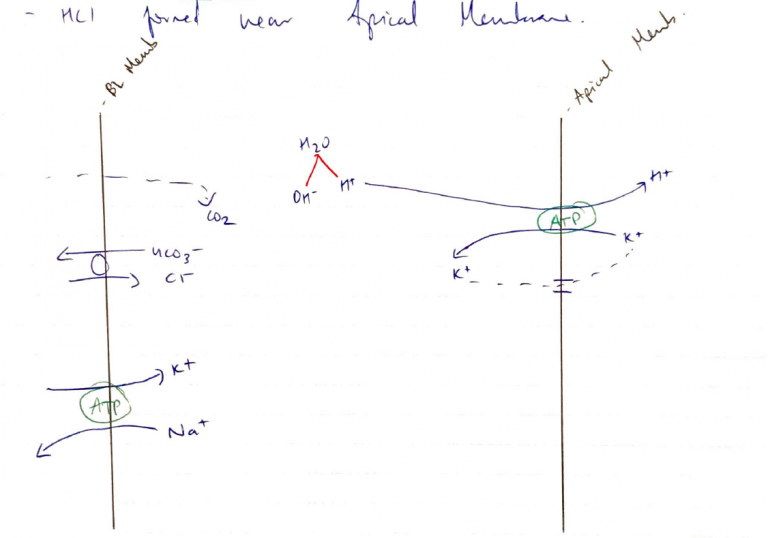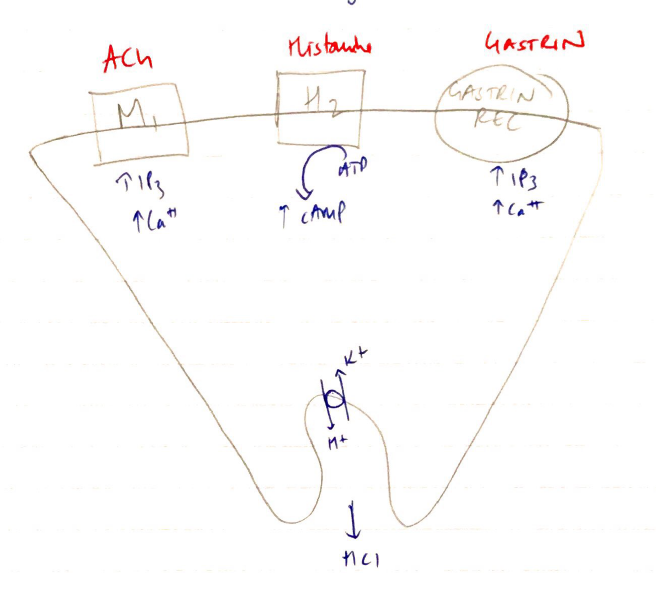O1i / 20B16: Gastric acid secretion
20B16: Exam Report
Describe the formation of gastric acid (50% marks) and the regulation of gastric acid secretion (50% marks).
26% of candidates passed this question.
The is question was divided into two sections offering equal marks. The first section required a description of the generation and transport of both H+ and Clinto the stomach lumen by the parietal cell. The contributions of basolateral and luminal ion channels, the role of carbonic anhydrase and accurate description of the net flux was expected for full marks. The second
section required comments on the roles of neural and endocrine regulation. Increased acid secretion via acetylcholine (via muscarinic M3), histamine (via H2) and gastrin were expected as was reduced secretion via secretin and somatostatin. Better responses were able to combine and integrate these into cephalic, gastric, and intestinal phases. The nature and function of other gastric secretions and the role of pharmacologic agents was not asked for and therefore not awarded any marks.
O1i / 20B16: Gastric acid secretion
Overview
- Gastric acid (pH 1.6) is one component of gastric acid secretion
2L of gastric secretions produced daily - Gastric acid is produced by parietal cells and is essential for
- Innate immunity
- Optimal pH for Pepsin activity
- Conversion of ferric ion to ferrous ion
- Stimulation of pancreatic and biliary secretions
Parietal Cells
- Body + fundus of stomach
- Contain H/K/ATPase pump on the Apical Membrane
- Secrete:
- HCl → breakdown of protein
- Intrinsic Factor → absorption of B12
HCL Secretion

- H2O enters parietal cells by osmosis and dissociates into H+ and HCO3 by the action of Carbonic Anhydrase: H2O + CO2 ⇔ H2CO3 ⇔ H+ + HCO3–
- At the Apical Membrane:
- H+ is pumped out by the H/K/ATPase “Proton Pump”
- K levels are maintained high enough for the Proton Pump by BL Na/K/ATPase pump and by conductance channels which allow K to leak back into the cell maintaining electroneutrality for the H+ loss
- At the Basolateral Membrane:
- HCO3- is exchanged for Cl-
- Causes a slight rise in blood pH
- Contains the Na/K/ATPase
Stimulation of Acid Secretion
- The H/K/ATPase is a GPCR sensitive to intracellular Ca++
- Stimulated by: Ach (M3) Histamine (H2), Gastrin
- Inhibited by: Somatostatin, Epidermal Growth Factor, b-agonist, high [gastric acid]

Regulation of Acid Secretion
- CEPHALIC PHASE: Vagus releases ACh → ↑acid production + inhibits somatostatin
- GASTRIC PHASE: amino acids + peptides directly sitmulate Parietal cells to ↑acid production
- But ↑↑acid production inhibits its own formation & ↑somatostatin
- INTESTINAL PHASE: Protein/amino acids in duodenum → ↑acid production
- ↑fat & H+ → ↓acid production & ↑somatostatin
Author: Krisoula Zahariou